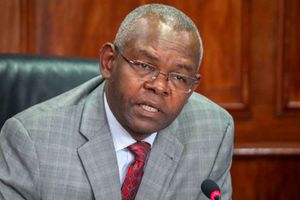Breaking News: Former Lugari MP Cyrus Jirongo dies in a road crash

Despite surge in bad loans, banks have continued to lend to households and companies.
The high inflationary pressures caused by steep consumer prices, which hit the domestic market forced the Central Bank of Kenya (CBK) on December 5, to raise its benchmark lending rate by 200 basis points
Known as the Central Bank Rate (CBR), this lending rate is used by the banking sector regulator to stabilise prices by either reducing or increasing supply of money in the market. Recently, owing to high consumer prices, the CBK tried to cut the supply of money into the economy by raising the CBR, which is the rate at which banks borrow from CBK for onward lending to various economic sectors.
As a result, lending rates by commercial banks rose to 14.16 per cent in October last year, the highest since August 2016 when the country still had interest rate caps. The higher rate has seen many borrowers default on their loans.
But despite the surge in bad loans, banks have continued to lend to households and companies, with private sector credit growing at double digits. One of the reasons banks have continued to do this in an environment of surging defaults, is the use of credit scores by banks computed by the three Credit Reference Bureaus (CRBs).
With this tool, banks have continued advancing loans in a high-risk conditions characterised by a jump in bad loans, a top executive in one of the three CRBs says.
In February 2014, all banks started sharing records about all their borrowers, not just defaulters. With the credit sharing mechanism, lenders are able to access data on customers’ credit history and lend to them even as bad loans, or those which have gone for 90 days without being serviced, surge.
Mr Gideon Kipyakwai, the chief executive officer of Metropol Corporation, one of the three CRBs, said proper pricing of risk due to credit scores computed by CRBs was the reason banks continue to lend even as the share of non-performing loans (NPLs) to gross loans jumped to 15 per cent by end of September.
NPLs are loans, which have not been serviced for more than three months.
“The role of CRBs in these credit transactions is so important, especially in the current digital age, that most institutions today cannot fathom processing a loan or any credit line without checking a borrower's CRB score or credit rating to ascertain credit worthiness,” said Mr Kipyakwai.
He said a borrower’s credit risk in the current risk-based pricing is reflected in the interest rates being charged.
“Properly pricing risk enables lenders to continue to lend even when the credit market is struggling. For instance, even with the slight increase in NPLs in Q3 to 15 per cent, lenders continue to lend, albeit with a higher interest rate, without losing their capital or return,” added Mr Kipyakwai.
Data from the Central Bank of Kenya (CBK), the financial regulator, shows that credit to the private sector continued to grow at double digits despite the spike in NPL as lenders relied on risk-based pricing to profile credit-worthy borrowers.
Private sector credit grew at 12.5 per cent in October 2023 and 12.2 per cent in September, as lending to firms and households continue to grow at double-digit since the country ended the interest rate caps in 2018.
Dr Kamau Thugge, the CBK governor, noted that the strong credit growth was observed in the manufacturing sector (18.4 percent), transport and communication (16.2 per cent), trade (9.9 per cent), and consumer durables (10.8 per cent).
“The number of loan applications and approvals remained strong, reflecting sustained demand particularly for working capital requirements,” said Thugge.
Credit growth is expected to rise further this year as the government reduces its borrowing from the domestic credit market, according to a new report by the World Bank.

Treasury Cabinet Secretary Njuguna Ndung’u (left) and Central Bank of Kenya Governor Kamau Thugge. Inset: Chairperson of the President’s Council of Economic Advisors, David Ndii.
Increased borrowing by the private sector will help push the country’s economic growth in 2024 to 5.2 per cent this year, which is higher than the World Bank’s estimated gross domestic product (GDP) growth of five percent last year.
“Increasing investment is expected to drive growth in Kenya and Uganda, partly owing to improved business confidence,” says the World Bank.
Also Read: Money men double speak - Thugge, Ndung'u ‘contradict each other’ on fall of shilling, higher taxes
“Uganda will also benefit from infrastructure investment ahead of new oil production in 2025, and investment in Kenya should be boosted by increased credit to the private sector as the government reduces domestic borrowing.
Credit information sharing
Former CBK governor, Dr Patrick Njoroge, pushed for the strengthening of the credit information sharing (CIS) framework to support implementation of risk-based credit pricing in the banking sector.
“Towards this end, Credit Reference Bureaus (CRBs) will improve the quality of their reports and enhance the robustness of their credit scoring models and align them to best practice,” said Dr Njoroge who has since been replaced by Dr Kamau Thugge.
On November 10, 2022, CBK mandated all CRBs to include a standard statement at the top of every credit report indicating that a customer’s credit score should not be used as the sole reason by a lender to deny a customer a loan.
“Additionally, CBK has reminded banks to consider the credit scores of borrowers in addition to other factors in making lending decisions,” added Dr Njoroge.
Under the CIS framework, there are three CRBs. Besides Metropol, others are TransUnion and Creditinfo.
When President William Ruto came to power, he directed that more than four million loan defaulters be removed from CRB blacklists in a plan that was aimed at reforming the country’s credit market.
The President directed the CBK to abolish the blacklisting of borrowers and instead have a scoring method where defaulters will get a low grade instead of being shut out of the financial system.











